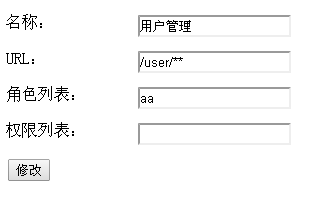Shiro 动态 URL
用过 Spring Security 的朋友应该比较熟悉对 URL 进行全局的权限控制,即访问 URL 时进行权限匹配;如果没有权限直接跳到相应的错误页面。Shiro 也支持类似的机制,不过需要稍微改造下来满足实际需求。不过在 Shiro 中,更多的是通过 AOP 进行分散的权限控制,即方法级别的;而通过 URL 进行权限控制是一种集中的权限控制。本章将介绍如何在 Shiro 中完成动态 URL 权限控制。
本章代码基于《第十六章 综合实例》,请先了解相关数据模型及基本流程后再学习本章。
表及数据 SQL
请运行 shiro-example-chapter19/sql/ shiro-schema.sql 表结构
请运行 shiro-example-chapter19/sql/ shiro-schema.sql 数据
实体
具体请参考 com.github.zhangkaitao.shiro.chapter19 包下的实体。
public class UrlFilter implements Serializable {
private Long id;
private String name; //url名称/描述
private String url; //地址
private String roles; //所需要的角色,可省略
private String permissions; //所需要的权限,可省略
} 表示拦截的 URL 和角色 / 权限之间的关系,多个角色 / 权限之间通过逗号分隔,此处还可以扩展其他的关系,另外可以加如 available 属性表示是否开启该拦截。
DAO
具体请参考 com.github.zhangkaitao.shiro.chapter19.dao 包下的 DAO 接口及实现。
Service
具体请参考 com.github.zhangkaitao.shiro.chapter19.service 包下的 Service 接口及实现。
public interface UrlFilterService {
public UrlFilter createUrlFilter(UrlFilter urlFilter);
public UrlFilter updateUrlFilter(UrlFilter urlFilter);
public void deleteUrlFilter(Long urlFilterId);
public UrlFilter findOne(Long urlFilterId);
public List<UrlFilter> findAll();
}基本的 URL 拦截的增删改查实现。
@Service
public class UrlFilterServiceImpl implements UrlFilterService {
@Autowired
private ShiroFilerChainManager shiroFilerChainManager;
@Override
public UrlFilter createUrlFilter(UrlFilter urlFilter) {
urlFilterDao.createUrlFilter(urlFilter);
initFilterChain();
return urlFilter;
}
//其他方法请参考源码
@PostConstruct
public void initFilterChain() {
shiroFilerChainManager.initFilterChains(findAll());
}
} UrlFilterServiceImpl 在进行新增、修改、删除时会调用 initFilterChain 来重新初始化 Shiro 的 URL 拦截器链,即同步数据库中的 URL 拦截器定义到 Shiro 中。此处也要注意如果直接修改数据库是不会起作用的,因为只要调用这几个 Service 方法时才同步。另外当容器启动时会自动回调 initFilterChain 来完成容器启动后的 URL 拦截器的注册。
ShiroFilerChainManager
@Service
public class ShiroFilerChainManager {
@Autowired private DefaultFilterChainManager filterChainManager;
private Map<String, NamedFilterList> defaultFilterChains;
@PostConstruct
public void init() {
defaultFilterChains =
new HashMap<String, NamedFilterList>(filterChainManager.getFilterChains());
}
public void initFilterChains(List<UrlFilter> urlFilters) {
//1、首先删除以前老的filter chain并注册默认的
filterChainManager.getFilterChains().clear();
if(defaultFilterChains != null) {
filterChainManager.getFilterChains().putAll(defaultFilterChains);
}
//2、循环URL Filter 注册filter chain
for (UrlFilter urlFilter : urlFilters) {
String url = urlFilter.getUrl();
//注册roles filter
if (!StringUtils.isEmpty(urlFilter.getRoles())) {
filterChainManager.addToChain(url, "roles", urlFilter.getRoles());
}
//注册perms filter
if (!StringUtils.isEmpty(urlFilter.getPermissions())) {
filterChainManager.addToChain(url, "perms", urlFilter.getPermissions());
}
}
}
} 1、init:Spring 容器启动时会调用 init 方法把在 spring 配置文件中配置的默认拦截器保存下来,之后会自动与数据库中的配置进行合并。
2、initFilterChains:UrlFilterServiceImpl 会在 Spring 容器启动或进行增删改 UrlFilter 时进行注册 URL 拦截器到 Shiro。
拦截器及拦截器链知识请参考《第八章 拦截器机制》,此处再介绍下 Shiro 拦截器的流程:
AbstractShiroFilter //如ShiroFilter/ SpringShiroFilter都继承该Filter
doFilter //Filter的doFilter
doFilterInternal //转调doFilterInternal
executeChain(request, response, chain) //执行拦截器链
FilterChain chain = getExecutionChain(request, response, origChain) //使用原始拦截器链获取新的拦截器链
chain.doFilter(request, response) //执行新组装的拦截器链
getExecutionChain(request, response, origChain) //获取拦截器链流程
FilterChainResolver resolver = getFilterChainResolver(); //获取相应的FilterChainResolver
FilterChain resolved = resolver.getChain(request, response, origChain); //通过FilterChainResolver根据当前请求解析到新的FilterChain拦截器链默认情况下如使用 ShiroFilterFactoryBean 创建 shiroFilter 时,默认使用 PathMatchingFilterChainResolver 进行解析,而它默认是根据当前请求的 URL 获取相应的拦截器链,使用 Ant 模式进行 URL 匹配;默认使用 DefaultFilterChainManager 进行拦截器链的管理。
PathMatchingFilterChainResolver 默认流程:
public FilterChain getChain(ServletRequest request, ServletResponse response, FilterChain originalChain) {
//1、首先获取拦截器链管理器
FilterChainManager filterChainManager = getFilterChainManager();
if (!filterChainManager.hasChains()) {
return null;
}
//2、接着获取当前请求的URL(不带上下文)
String requestURI = getPathWithinApplication(request);
//3、循环拦截器管理器中的拦截器定义(拦截器链的名字就是URL模式)
for (String pathPattern : filterChainManager.getChainNames()) {
//4、如当前URL匹配拦截器名字(URL模式)
if (pathMatches(pathPattern, requestURI)) {
//5、返回该URL模式定义的拦截器链
return filterChainManager.proxy(originalChain, pathPattern);
}
}
return null;
} 默认实现有点小问题:
如果多个拦截器链都匹配了当前请求 URL,那么只返回第一个找到的拦截器链;后续我们可以修改此处的代码,将多个匹配的拦截器链合并返回。
DefaultFilterChainManager 内部使用 Map 来管理 URL 模式 - 拦截器链的关系;也就是说相同的 URL 模式只能定义一个拦截器链,不能重复定义;而且如果多个拦截器链都匹配时是无序的(因为使用 map.keySet() 获取拦截器链的名字,即 URL 模式)。
FilterChainManager 接口:
public interface FilterChainManager {
Map<String, Filter> getFilters(); //得到注册的拦截器
void addFilter(String name, Filter filter); //注册拦截器
void addFilter(String name, Filter filter, boolean init); //注册拦截器
void createChain(String chainName, String chainDefinition); //根据拦截器链定义创建拦截器链
void addToChain(String chainName, String filterName); //添加拦截器到指定的拦截器链
void addToChain(String chainName, String filterName, String chainSpecificFilterConfig) throws ConfigurationException; //添加拦截器(带有配置的)到指定的拦截器链
NamedFilterList getChain(String chainName); //获取拦截器链
boolean hasChains(); //是否有拦截器链
Set<String> getChainNames(); //得到所有拦截器链的名字
FilterChain proxy(FilterChain original, String chainName); //使用指定的拦截器链代理原始拦截器链
} 此接口主要三个功能:注册拦截器,注册拦截器链,对原始拦截器链生成代理之后的拦截器链,比如
<bean id="shiroFilter" class="org.apache.shiro.spring.web.ShiroFilterFactoryBean">
……
<property name="filters">
<util:map>
<entry key="authc" value-ref="formAuthenticationFilter"/>
<entry key="sysUser" value-ref="sysUserFilter"/>
</util:map>
</property>
<property name="filterChainDefinitions">
<value>
/login = authc
/logout = logout
/authenticated = authc
/** = user,sysUser
</value>
</property>
</bean> filters 属性定义了拦截器;filterChainDefinitions 定义了拦截器链;如 /** 就是拦截器链的名字;而 user,sysUser 就是拦截器名字列表。
之前说过默认的 PathMatchingFilterChainResolver 和 DefaultFilterChainManager 不能满足我们的需求,我们稍微扩展了一下:
CustomPathMatchingFilterChainResolver
public class CustomPathMatchingFilterChainResolver
extends PathMatchingFilterChainResolver {
private CustomDefaultFilterChainManager customDefaultFilterChainManager;
public void setCustomDefaultFilterChainManager(
CustomDefaultFilterChainManager customDefaultFilterChainManager) {
this.customDefaultFilterChainManager = customDefaultFilterChainManager;
setFilterChainManager(customDefaultFilterChainManager);
}
public FilterChain getChain(ServletRequest request, ServletResponse response, FilterChain originalChain) {
FilterChainManager filterChainManager = getFilterChainManager();
if (!filterChainManager.hasChains()) {
return null;
}
String requestURI = getPathWithinApplication(request);
List<String> chainNames = new ArrayList<String>();
for (String pathPattern : filterChainManager.getChainNames()) {
if (pathMatches(pathPattern, requestURI)) {
chainNames.add(pathPattern);
}
}
if(chainNames.size() == 0) {
return null;
}
return customDefaultFilterChainManager.proxy(originalChain, chainNames);
}
} 和默认的 PathMatchingFilterChainResolver 区别是,此处得到所有匹配的拦截器链,然后通过调用 CustomDefaultFilterChainManager.proxy(originalChain, chainNames) 进行合并后代理。
CustomDefaultFilterChainManager
public class CustomDefaultFilterChainManager extends DefaultFilterChainManager {
private Map<String, String> filterChainDefinitionMap = null;
private String loginUrl;
private String successUrl;
private String unauthorizedUrl;
public CustomDefaultFilterChainManager() {
setFilters(new LinkedHashMap<String, Filter>());
setFilterChains(new LinkedHashMap<String, NamedFilterList>());
addDefaultFilters(true);
}
public Map<String, String> getFilterChainDefinitionMap() {
return filterChainDefinitionMap;
}
public void setFilterChainDefinitionMap(Map<String, String> filterChainDefinitionMap) {
this.filterChainDefinitionMap = filterChainDefinitionMap;
}
public void setCustomFilters(Map<String, Filter> customFilters) {
for(Map.Entry<String, Filter> entry : customFilters.entrySet()) {
addFilter(entry.getKey(), entry.getValue(), false);
}
}
public void setDefaultFilterChainDefinitions(String definitions) {
Ini ini = new Ini();
ini.load(definitions);
Ini.Section section = ini.getSection(IniFilterChainResolverFactory.URLS);
if (CollectionUtils.isEmpty(section)) {
section = ini.getSection(Ini.DEFAULT_SECTION_NAME);
}
setFilterChainDefinitionMap(section);
}
public String getLoginUrl() {
return loginUrl;
}
public void setLoginUrl(String loginUrl) {
this.loginUrl = loginUrl;
}
public String getSuccessUrl() {
return successUrl;
}
public void setSuccessUrl(String successUrl) {
this.successUrl = successUrl;
}
public String getUnauthorizedUrl() {
return unauthorizedUrl;
}
public void setUnauthorizedUrl(String unauthorizedUrl) {
this.unauthorizedUrl = unauthorizedUrl;
}
@PostConstruct
public void init() {
Map<String, Filter> filters = getFilters();
if (!CollectionUtils.isEmpty(filters)) {
for (Map.Entry<String, Filter> entry : filters.entrySet()) {
String name = entry.getKey();
Filter filter = entry.getValue();
applyGlobalPropertiesIfNecessary(filter);
if (filter instanceof Nameable) {
((Nameable) filter).setName(name);
}
addFilter(name, filter, false);
}
}
Map<String, String> chains = getFilterChainDefinitionMap();
if (!CollectionUtils.isEmpty(chains)) {
for (Map.Entry<String, String> entry : chains.entrySet()) {
String url = entry.getKey();
String chainDefinition = entry.getValue();
createChain(url, chainDefinition);
}
}
}
protected void initFilter(Filter filter) {
//ignore
}
public FilterChain proxy(FilterChain original, List<String> chainNames) {
NamedFilterList configured = new SimpleNamedFilterList(chainNames.toString());
for(String chainName : chainNames) {
configured.addAll(getChain(chainName));
}
return configured.proxy(original);
}
private void applyGlobalPropertiesIfNecessary(Filter filter) {
applyLoginUrlIfNecessary(filter);
applySuccessUrlIfNecessary(filter);
applyUnauthorizedUrlIfNecessary(filter);
}
private void applyLoginUrlIfNecessary(Filter filter) {
//请参考源码
}
private void applySuccessUrlIfNecessary(Filter filter) {
//请参考源码
}
private void applyUnauthorizedUrlIfNecessary(Filter filter) {
//请参考源码
}
} - CustomDefaultFilterChainManager:调用其构造器时,会自动注册默认的拦截器;
- loginUrl、successUrl、unauthorizedUrl:分别对应登录地址、登录成功后默认跳转地址、未授权跳转地址,用于给相应拦截器的;
- filterChainDefinitionMap:用于存储如 ShiroFilterFactoryBean 在配置文件中配置的拦截器链定义,即可以认为是默认的静态拦截器链;会自动与数据库中加载的合并;
- setDefaultFilterChainDefinitions:解析配置文件中传入的字符串拦截器链配置,解析为相应的拦截器链;
- setCustomFilters:注册我们自定义的拦截器;如 ShiroFilterFactoryBean 的 filters 属性;
- init:初始化方法,Spring 容器启动时会调用,首先其会自动给相应的拦截器设置如 loginUrl、successUrl、unauthorizedUrl;其次根据 filterChainDefinitionMap 构建默认的拦截器链;
- initFilter:此处我们忽略实现 initFilter,因为交给 spring 管理了,所以 Filter 的相关配置会在 Spring 配置中完成;
- proxy:组合多个拦截器链为一个生成一个新的 FilterChain 代理。
Web 层控制器
请参考 com.github.zhangkaitao.shiro.chapter19.web.controller 包,相对于第十六章添加了 UrlFilterController 用于 UrlFilter 的维护。另外,移除了控制器方法上的权限注解,而是使用动态 URL 拦截进行控制。
Spring 配置——spring-config-shiro.xml
<bean id="filterChainManager"
class="com.github.zhangkaitao.shiro.spring.CustomDefaultFilterChainManager">
<property name="loginUrl" value="/login"/>
<property name="successUrl" value="/"/>
<property name="unauthorizedUrl" value="/unauthorized.jsp"/>
<property name="customFilters">
<util:map>
<entry key="authc" value-ref="formAuthenticationFilter"/>
<entry key="sysUser" value-ref="sysUserFilter"/>
</util:map>
</property>
<property name="defaultFilterChainDefinitions">
<value>
/login = authc
/logout = logout
/unauthorized.jsp = authc
/** = user,sysUser
</value>
</property>
</bean> filterChainManager 是我们自定义的 CustomDefaultFilterChainManager,注册相应的拦截器及默认的拦截器链。
<bean id="filterChainResolver"
class="com.github.zhangkaitao.shiro.spring.CustomPathMatchingFilterChainResolver">
<property name="customDefaultFilterChainManager" ref="filterChainManager"/>
</bean> filterChainResolver 是自定义的 CustomPathMatchingFilterChainResolver,使用上边的 filterChainManager 进行拦截器链的管理。
<bean id="shiroFilter" class="org.apache.shiro.spring.web.ShiroFilterFactoryBean">
<property name="securityManager" ref="securityManager"/>
</bean> shiroFilter 不再定义 filters 及 filterChainDefinitions,而是交给了 filterChainManager 进行完成。
<bean class="org.springframework.beans.factory.config.MethodInvokingFactoryBean">
<property name="targetObject" ref="shiroFilter"/>
<property name="targetMethod" value="setFilterChainResolver"/>
<property name="arguments" ref="filterChainResolver"/>
</bean> 最后把 filterChainResolver 注册给 shiroFilter,其使用它进行动态 URL 权限控制。
其他配置和第十六章一样,请参考第十六章。
测试
1、首先执行 shiro-data.sql 初始化数据。
2、然后再 URL 管理中新增如下数据:

3、访问 http://localhost:8080/chapter19/user 时要求用户拥有 aa 角色,此时是没有的所以会跳转到未授权页面;
4、添加 aa 角色然后授权给用户,此时就有权限访问 http://localhost:8080/chapter19/user。
实际项目可以在此基础上进行扩展。



